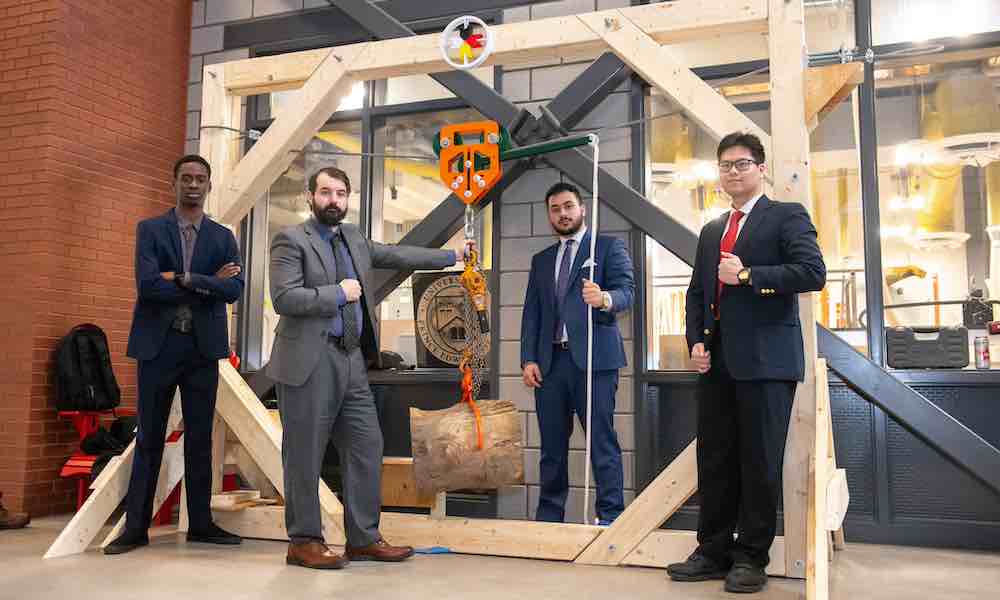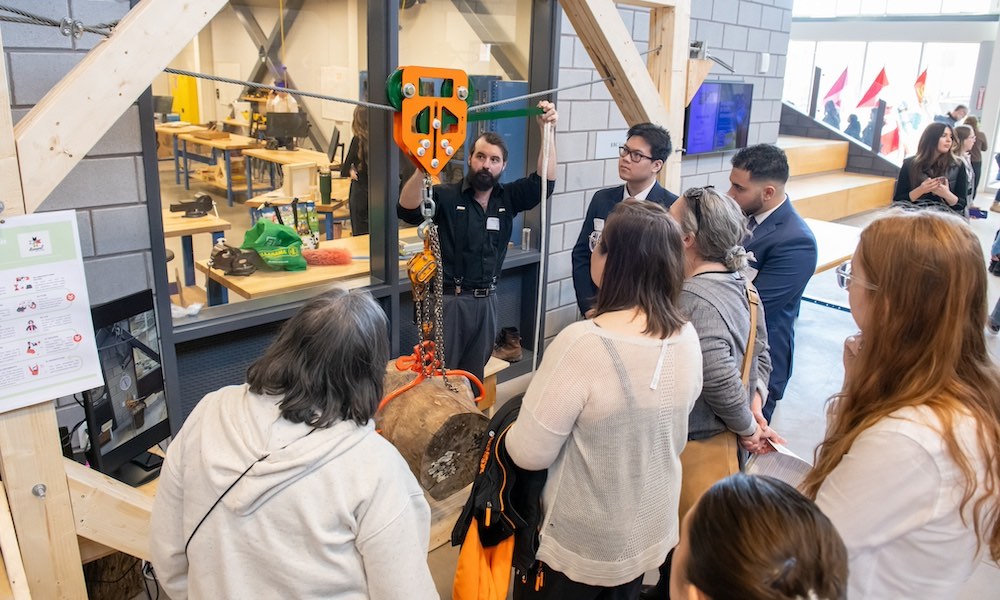"It's showed us how engineers go through the process of solving problems."
In the second, third, and fourth years of UPEI's Bachelor of Sustainable Design Engineering program, students form small groups to participate in a year-long design and implementation project with a corporate or community partner. Described as "an opportunity for students to act as engineering consultants for a company or organization, where teams of students team solve an actual technical challenge from the partner's operation", the design clinic program is a truly hands-on, real-world learning experience.
Student team members Remi Antoun, James Campbell, Chukwuma "Prince" Ezeilo, and Huy "Alvin" Nguyen worked with the Abegweit First Nation to solve the ongoing challenge of transforming wind-damaged forests into productive blueberry crops while safeguarding the suitability of the land for wild blueberry cultivation. Current methods and machinery for commercial tree removal are prohibitively expensive and pose a risk to the land’s suitability for blueberry propagation.
To address this challenge, the team designed and developed a manual braking and cable car-like pulley mechanism to safely and effectively move fallen trees as an affordable and sustainable solution that preserves the cultural and environmental values of the community.

Before showcasing their project at the 2024 Engineering Student Design Expo in April, the team reflected on their experience.
How did you choose Sustainable Design Engineering at UPEI?
"I'm originally from Vietnam, and after I graduated from high school I went to UPEI's Open House for prospective students and saw a lot of cool stuff in the Engineering program," says Alvin. "When I learned that first-year students actually work with community and industry partners as clients right from the start, that's the main reason I chose this program at UPEI."
"My older sister and cousin are Engineering students here at UPEI and I thought it would be interesting and great for me, too," says Remi.
"I'm from Nigeria, and I chose UPEI because I loved their Engineering program, and the sustainable design aspect was something I was looking for," says Prince.
"I live on Prince Edward Island, and nine generations of my family have lived here," says James. "I live on a rural family farm which I want to try to automate and improve. I joined the Engineering program here as an adult to try and learn how to do that."
What kinds of challenges did you face during the project, and what did you particularly enjoy about the work?
"Halfway through the first semester we received the project and the problem to solve," says James. "So for that semester we wrote reports of our planning. We spent the second semester building and testing. Being able to use the Sustainable Design Engineering facility and the resources and tools here is awesome, and the access to the shop materials and working spaces is key to the success of our project. The design spiral is very important to us, the trying and failing and trying again and failing again is key."
"For me, the main challenge was designing and building the device," says Remi. "Figuring out lengths of materials, and the distances and forces required to accurately design the braking mechanism took a lot of testing, a lot of trial and error. My favourite part is at the end, when we're done, and we can start painting, and assembling everything. That's when we find out our devices work and that we've got it right."
"My favourite part of the project was the second week of the second semester when we get to go and test the prototype we constructed out of wood," says Alvin. "It really helped us see how components would fit together and how our design might work when completed."
"It was a challenge but getting the brakes to work manually," says Prince. "That's the part that makes this design and concept different from a normal cable car system. We could have designed it on a computer but until we had something real in front of us that experience helped us learn a lot."

What impacts has your involvement in this project had for you?
"I've learned CAD, and other technical skills since my first year but more about being confident, presenting to people and giving presentations," says Alvin. "These skills will be very useful for me in the future when I go to work."
"It's showed me how engineers go through the process of solving problems," says Remi. "I'm looking forward to finding work this summer as an intern, or with a company to build on what I've learned."
"Working with a community partner has helped me learn a lot," says Prince. "It's made me want to continue to build on my skills, think outside the box more to solve problems, and things like that."
"I'm hoping to copy this design, improve on it, and utilize it on my farm for loading my sawmill," says James. "Using the design spiral was really important—try something, fail, try something else, fail."
